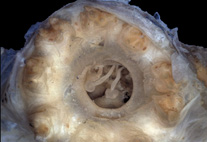Abstract
The advertisement call of Dermatonotus muelleri was originally described by Nelson (1973) in a brief section of a review on the mating calls of the Microhylinae. He used two calls from São Leopoldo, state of Minas Gerais, in Brazil to determine that they have i) dominant frequency between 1.500−2.200 kHz (mean 1.854 + 0.216 kHz), and ii) harmonic intervals between 0.140 and 0.150 kHz (0.146 +/- 0.005 kHz). Nelson (1973) based his description on an audiospectrogram produced with high frequency resolution and did not quantify the pulse structure of the calls. More recently, Giaretta and colleagues (2013) expanded on the original description using a larger set of calls recorded from Gurinhat, state of Minas Gerais, in Brazil. They quantified the temporal structure of the call and confirmed that the dominant frequency is around 1.8 kHz. In addition, they identified a secondary low frequency band at 667 Hz.

